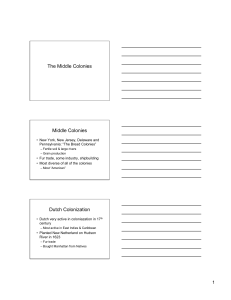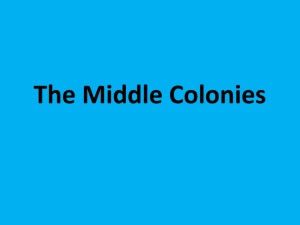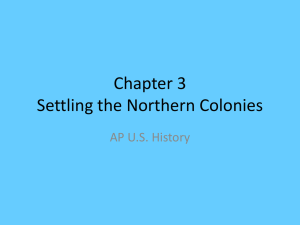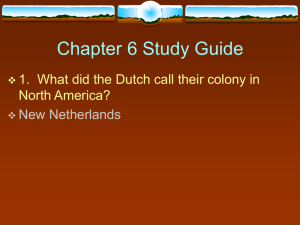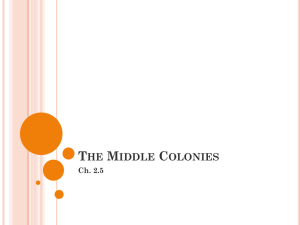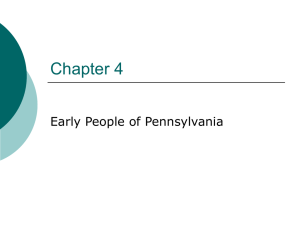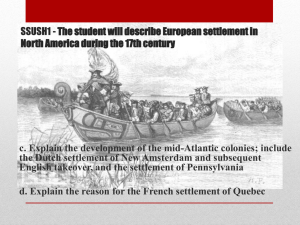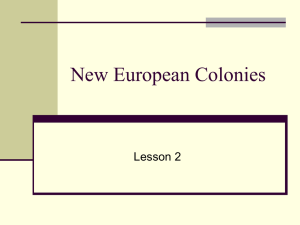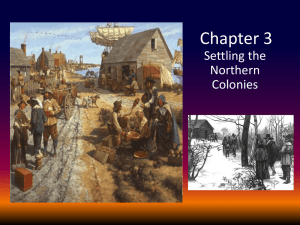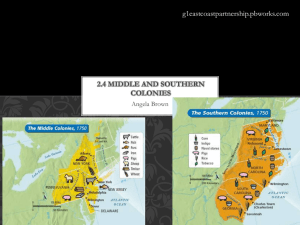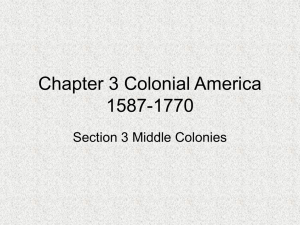to See an Abbreviated Sample: The Middle
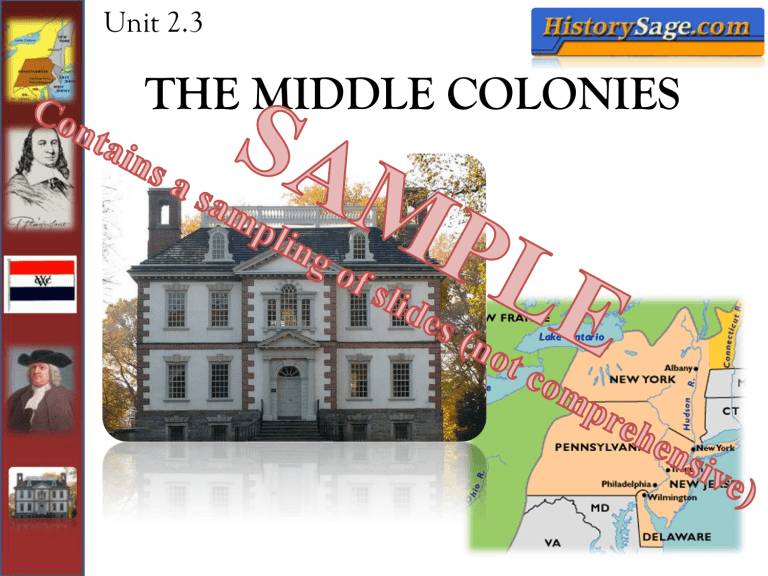
Unit 2.3
THE MIDDLE COLONIES
Key Concept 2.1
Differences in imperial goals, cultures, and the North American environments that different empires confronted led Europeans to develop diverse patterns of colonization.
Source: College Board, AP United States History Course and Exam
Description (Including the Curriculum Framework)
Learning Objective 1
Students will analyze the development of the Middle (Mid-
Atlantic) colonies in the 17
th
and
18
th
centuries.
Unit 2.3
The Middle Colonies
Theme:
The middle colonies developed far greater political, ethnic, religious, and social diversity and represented a more cosmopolitan middle ground between the tightly knit New England towns and the scattered, hierarchical plantation South.
I. Characteristics of Middle Colonies:
NY, NJ, DE, PA
A. Excellent land for farming: region became known as the "bread colonies" for exports of grain; also fruits and vegetables.
B. Three rivers – Susquehanna, Delaware, and
Hudson – provided a the means to tap the fur trade in the interior.
C. Less aristocratic than New England and the
Southern colonies (except NY)
• Land holdings were intermediate in size
(except NY)
D. Fewer industries than New England; more than in the South
1. Shipbuilding and lumbering also important (not as large-scale as New
England)
2. Shipping and commerce
E. Population was the most ethnically mixed; religiously tolerant; democratically controlled (less so in NY)
• Yet, much factional conflict among groups.
II. New York
A. Rise of the Dutch in North America
1. Henry Hudson, Englishman who was employed by the Dutch East India Co., sailed into Delaware and NY bays in
1609, and traveled up the Hudson River.
2. New Netherlands founded in
1623-1624 on the Hudson
River by Peter Minuit a. Established by the Dutch
West India Company for quick-profit fur trade.
b. Manhattan Island bought from Amerindians for about $30.
New
Amsterdam,
1660
3. New Amsterdam (modern-day NYC) was founded as a company town/seaport a. City run by the DWIC in the interest of the stockholders b. Little religious toleration, free speech, or democratic practices c. Much grain production for export along the Hudson River Valley
d. Patroonship: Aristocratic structure; resembled serfdom
• Huge estates granted to promoters who would settle 50 persons on them. (One estate in Albany was larger than Rhode Island!)
• Lowly laborers worked long hours growing grain for export.
• After repeated protests, a semirepresentative body was finally granted.
e. Cosmopolitan town: by the 1640s 18 different languages were spoken there
f. Intermarriage between Dutch settlers and Amerindians was not uncommon
(in contrast to English settlers who rarely intermarried or had sexual relations with Amerindians or
Africans).
• Intermarriage was at times a means of tapping the fur trade (French traders also intermarried for economic opportunity).
B. Challenges to New Netherlands and defeat by England
1. Amerindians, in retaliation for Dutch violence, massacred settlers.
• A fort was built as a defense; located at today's Wall Street.
2. New England was hostile to the growth of New Netherlands; saw the Dutch as a threat.
3. Swedes trespassed on Dutch lands on the Delaware River. a. Established New Sweden between
1638-1655.
New Netherlands &
New Sweden
b. In 1655, a Dutch force led by Peter
Stuyvesant, ended Swedish rule.
c. Swedish colonists were absorbed by
New Netherlands.
4. 1664, Charles II ordered military removal of the Dutch from New
Netherlands. a. Peter Stuyvesant was forced to surrender.
b. Charles' brother, the Duke of York, was given control over the area.
5. Name of the colony changed to New
York.
C. New York Chapter of Liberties (1683)
1. Granted freedom of religion to all
Christians and gave all landholders suffrage.
2. Important as a step leading to eventual democracy in New York.
3. Limitations: a. Much land in the hands of a few landowners or speculators.
b. New York retained feudalistic traits more than any other colony in the
North (resembled southern plantation owners).
New York Manors and Land Grants
D. New York became a royal colony in 1685 when James II became king.
E. The economy benefitted from trade with
Iroquois and influx of some farm workers.
F. New York remained autocratic in character.
1. Discouraged many Europeans from coming to New York thus retarding its population growth.
2. Leisler’s Rebellion (1691) occurred in response a. Remnants of patroonships led to popular discontent as huge estates were parceled out to upper-class whites, crowding out poor farmers.
b. Jacob Leisler governed New York between 1689-91 and introduced some democratic practices and redistribution of land to poor laborers.
c. 1691, English gov’t sought to remove him d. A combination of poor whites and farmers led by Leisler put up armed resistance.
• Inspired by the "Glorious Revolution" and the overthrow of the Dominion of New England. e. The revolt failed, Leisler was hanged, and parceling out of huge estates continued.
f. Significance: demonstrated growing disaffection of lower classes against the privileged classes (Bacon’s Rebellion had occurred 15 years earlier).
• Other rebellions would follow in the
18 th century: Carolina Regulator
Movement (1739), Paxton Boys in
Pennsylvania (1764).
II. Pennsylvania (founded in 1681)
A. Quakers in England emerged during the mid-1600's (Religious Society of Friends)
1. Non-conformist in nature: more radical than the Puritans in opposing authority a. Refused to support the Anglican
Church with taxes b. Did not employ a paid clergy c. Took no oaths d. Made no deference to authority figures e. Pacifists: refused military service; advocated passive resistance
B. William Penn
1. Gained huge land grant from the king.
2. Primary motive for founding a colony: create a religious haven for Quakers
King Charles signing the Charter of
Pennsylvania, 1681
3. Secondary motives: Experiment with liberal ideas in gov't while making a profit.
• "Holy Experiment": Penn allowed religious toleration among many denominations in Pennsylvania
4. Pennsylvania became the best advertised of all the colonies.
a. Pamphlets were distributed in England,
Netherlands, France, and Germany.
• Promised cheap land, freedom of religion, and representative government.
b. These generous land policies attracted many immigrants.
c. PA also attracted carpenters, masons, shoemakers, and other manual workers.
C. Success of Pennsylvania
1. The colony became a major producer of grain and successfully traded with
Amerindians in the fur trade.
2. All Swedes, Finns, and Dutch in the area were naturalized.
3. Philadelphia was carefully planned and became one of the largest cities in North
America.
4. Representative gov't was established with landowners having voting rights.
a. No tax-supported state church b. Freedom of worship guaranteed to all residents c. No provisions were established for military defense as it was against
Quaker pacifist doctrine.
d. Quakers were strongly against slavery and eventually established the first abolitionist societies during the
Revolutionary era.
6. By the mid-17th century, relations with
Native Americans had deteriorated.
a. The “Walking Purchase” of 1737 swindled the Lenape (Delaware) Indians out of hundreds of thousands of acres.
b. Penn’s descendants were less interested in building on the good relations William
Penn had fostered.
7. By 1700, Pennsylvania was 4th largest colony (behind VA, MA, and MD) a. Quakers were shrewd businessmen; exported grain and other foodstuffs as part of the Atlantic trade.
b. PA attracted a large German population.
Royal
Three Types of Colonies by 1775
Proprietary Charter
•
•
•
•
•
•
•
•
•
•
Virginia
Massachusetts
New York
Maryland
South Carolina
North Carolina
New Hampshire
New Jersey
Delaware
Georgia
•
•
•
•
•
•
• Pennsylvania
New Hampshire (until
1641)
Maryland (until 1692)
South Carolina (until
1729)
New Jersey (until 1702)
Delaware (until 1703)
Georgia (until 1752)
•
•
•
•
• Connecticut
Rhode Island
Virginia (until 1624)
Massachusetts (until
1691)
North Carolina
(until 1729)
